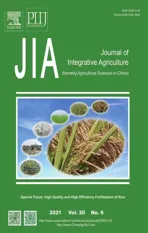Effect of side deep placement of nitrogen on yield and nitrogen use efficiency of single season late japonica rice
2021-05-23
Jiangsu Key Laboratory of Crop Genetics and Physiology/Jiangsu Co-Innovation Center for Modern Production Technology of Grain Crops/Agricultural College,Yangzhou University,Yangzhou 225009,P.R.China
Abstract Side deep placement of nitrogen plays an important role in improving rice yield and nitrogen use efficiency. Few studies have examined the effects of reducing the times of nitrogen (RTN) application and reducing the nitrogen rate (RNR) of application on rice yield and nitrogen use efficiency under side deep placement of nitrogen in paddy fields. Therefore,a field experiment of RNT and RNR treatments was conducted with nine fertilization modes during the 2018–2019 rice growing seasons in a rice–wheat cropping system of the lower reaches of the Yangtze River,China. Rice yield and nitrogen use efficiency were investigated under side deep placement of nitrogen. We found that under the same nitrogen application rate,the yield of RTN3 increased by 9.64 and 10.18% in rice varieties NJ9108 and NJ5718,respectively,compared with the farmers’ fertilizer practices (FFP). The nitrogen accumulation of RTN3 was the highest at heading stage,at 11.30 t ha–1 across 2018 and 2019. Under the same nitrogen application rate,the N agronomic use efficiency (NAE),N physiological efficiency (NPE) and N recovery efficiency (NRE) of RTN3 were 8.1–21.28%,8.51–41.76% and 0.28–14.52% higher than those of the other fertilization modes,respectively. RNR led to decreases in SPAD value,leaf area index (LAI),dry matter accumulation,nitrogen accumulation,and nitrogen use efficiency. These results suggest that RTN3 increased rice yield and nitrogen use efficiency under the side deep placement of nitrogen,and RNR1 could achieve the goals of saving cost and increasing resource use efficiency. Two fertilization modes RTN3 and RNR1 both could achieve the dual goals of increasing grain yield and resource use efficiency and thus are worth further application and investigation.
Keywords:japonica rice (Oryza sativa L.),fertilization mode,side deep placement of nitrogen,grain yield,nitrogen use efficiency
1.Introduction
Rice is one of the three major cereal crops in the world.Over 3.5 billion people around the world rely on rice as the staple food. In China,the rice-planting area has reached 31.04 million hectares,accounting for 26–28% of the total grain sown area,and total rice production accounts for 43–45% of the total grain production (Charleset al.2010;FAO 2017). Food security has always been the top priority of national economy and people’s livelihood. It is estimated that by 2030,with the continuing economic development and population growth,China will need to produce 20%more rice to meet the domestic consumption demand (Cai and Chen 2000).
Nitrogen is the most important fertilizer used in rice production,and its application is critical for grain production.It is the main means for improving rice yield so as to meet increasing food demand due to population growth (Spiertz 2010;Qiaoet al.2013). At present,the amount of nitrogen fertilizer used in China accounts for about 30% of the world total. The average N rate was 193 kg ha–1for irrigated rice in China in 2006,which was about 90% higher than the world average (Penget al.2010;FAO 2017). The main planting pattern in Jiangsu Province is rice–wheat cropping system.The average N rate in a single-season rice field is 272.24 kg ha–1,but may be as high as 300 kg ha–1in southern Jiangsu Province,which is 191.26% higher than the world average (Roelckeet al.2004). Excessive use of nitrogen fertilizer will not only increase production costs and reduce economic benefits,but also cause serious environmental pollution,including acid rain,soil acidification,and water eutrophication (Shiet al.2012;Zhaoet al.2012). In China,reducing fertilizer use,increasing nitrogen use efficiency and increasing rice yield have been promoted by government policies. Rice production has also shifted its single goal of high yield to multiple goals of high yield,high quality,high efficiency,ecology,and safety (Zhang 2007;Penget al.2009;Cuiet al.2018). Therefore,developing precise quantitative fertilization techniques is of great significance to rice production in the rice–wheat cropping system area.
Conventional nitrogen broadcasting is probably one of the most inefficient methods for rice production because of extensive nitrogen losses and difficulty in accurately controlling the depth of fertilization and the amount of fertilizer use per unit area (Zhanget al.2011). Deep side placement of fertilizer is a way of applying granular fertilizers to a specific depth of soil at the time of transplanting rice seedlings. That is to say,the fertilizer is applied in strips near root system,which is conducive to root absorption and thus greatly improves fertilizer utilization efficiency and reduces fertilizer water pollution (Wanget al.2019;Zhonget al.2019).Factors affecting rice yield and nitrogen use efficiency mainly include nitrogen application rate (Huoet al.2012b;Zhanget al.2012),deep placement of nitrogen fertilizer (Liuet al.2015;Zhanget al.2017),side deep placement technology(Xia and Wu 2014;Zhuet al.2019a),nitrogen fertilizer operation strategy (Huoet al.2012a;Huet al.2016),water and nitrogen management (Yanget al.2020),and fertilizer type (Liet al.2018;Weiet al.2018). Among these,side deep placement of fertilizer is an effective way to achieve the synergetic improvement of fertilizer use efficiency and rice yield (Kargboet al.2016;Maet al.2017). Zhuet al.(2019b)found that compared with traditional nitrogen broadcasting,mechanical side deep fertilization can significantly improve rice yield,N recovery efficiency (NRE) and N agronomic use efficiency (NAE),as they increased by 4.46–8.11%,17.91–54.10% and 19.61–37.39%,respectively. Under side deep fertilization,reducing N rate can improve the yield and nitrogen use efficiency of rice in paddy fields (Zhonget al.2019;Zhu 2019b). In general,there are 4–5 times of fertilizer application during the whole growth period of rice(Zhanget al.2019a). The effect of reducing the number of fertilization times on rice yield and nitrogen use efficiency needs further study under the condition of side deep placement of fertilizer.
There is a pressing need to increase grain production while protecting environmental quality in China and throughout the world. Latejaponicarice is mainly planted in Jiangsu Province,with a long growth period and low nitrogen use efficiency. There have been many reports about the effect of nitrogen application rate on the nitrogen use efficiency of rice,but studies of reducing nitrogen application rate and times on rice yield and nitrogen use efficiency under side deep fertilization are less common.Therefore,based on the rice–wheat cropping area in the lower reaches of the Yangtze river,experiments on the precise quantitative fertilization technology were conducted.We studied the effects of reducing the application times and rates of nitrogen on yield and nitrogen use efficiency of latejaponicarice in Xinghua in 2018 and 2019. Our objectives were to determine a precise quantitative fertilization method that can realize the dual benefits of cost saving and yield increase. This study seeks to provide a theoretical basis for improving the application of side deep placement of fertilization.
2.Materials and methods
2.1.Experimental location and weather conditions
Field experiments were conducted in a local farmer’s paddy field in Diaoyu town (33°05´N,119°58´E),Xinghua County,Jiangsu Province,China,during the rice growing seasons of 2018 and 2019. The cropping system in this experiment was a wheat–rice rotation system. The field soil was a clay loam with 25.6 g kg–1organic matter,1.65 g kg-1total N,12.8 mg kg-1Olsen-P,and 281.4 mg kg-1available K. The sunshine hours (Fig.1-A) and mean temperature (Fig.1-B)during the rice growing seasons of 2018 and 2019 were measured at a weather station near the experimental site as shown in Fig.1.
2.2.Arrangement of field experiments
Twojaponicarice (Oryza sativaL.) varieties widely grown in local production,Nanjing 9108 (NJ9108)and Nanjing 5718 (NJ5718),were used in this study.NJ9108,a late maturing mediumjaponicarice variety,was bred by crossing Wuxiangjing 14 (♀) and Kanto 194(♂). It’s plant height,growth period,amylose content,and gel consistency were 94.6 cm,153 d,9.34%,and 98 mm,respectively. NJ5718,a medium maturing mediumjaponicarice variety,was bred by crossing Ning 7022 (♀) and Yanjing 608 (♂). It’s plant height,growth period,amylose content,and gel consistency were 100.8 cm,150 d,10.3%,and 101 mm,respectively. The experiment was arranged in a split plot design,with planting method as main plot and variety as split plot. Seeds were sown in plastic plates on 3 June in both 2018 and 2019,with a seeding rate of 120 g of dry seeds per plate. Seedlings were manually transplanted in hills on 23 June of each year. The area of each experimental plot was 20 m2,with 50 cm spaces between the adjacent plots,and hill spacing was 12 cm×30 cm with four seedlings per hill. Each plot was separated by a soil ridge (35 cm wide and 20 cm high) and covered with a plastic film. The individual plants of each accession were planted in separate plots with three replications. Details of precise quantitative nitrogen application treatments for each plot are shown in Table 1. Nine treatments were set up in these experiments.In addition to the farmers’ fertilizer practice and no nitrogen application (0N),artificial simulation of side deep fertilization was used for basal fertilization. The leaf ages of NJ9108 and NJ5718 were 16 leaves. According to the method of Linget al.(1980),the leaf was marked during the whole growth period of the rice and nitrogen was then applied according to the leaf age. Calcium superphosphate (P2O5content:12%) and potassium chloride (K2O content:60%)were applied as basal at the rates of 150 kg P2O5ha-1and 240 kg K2O ha-1,respectively. Insect pests,pathogens and weeds were controlled using common chemical treatments.
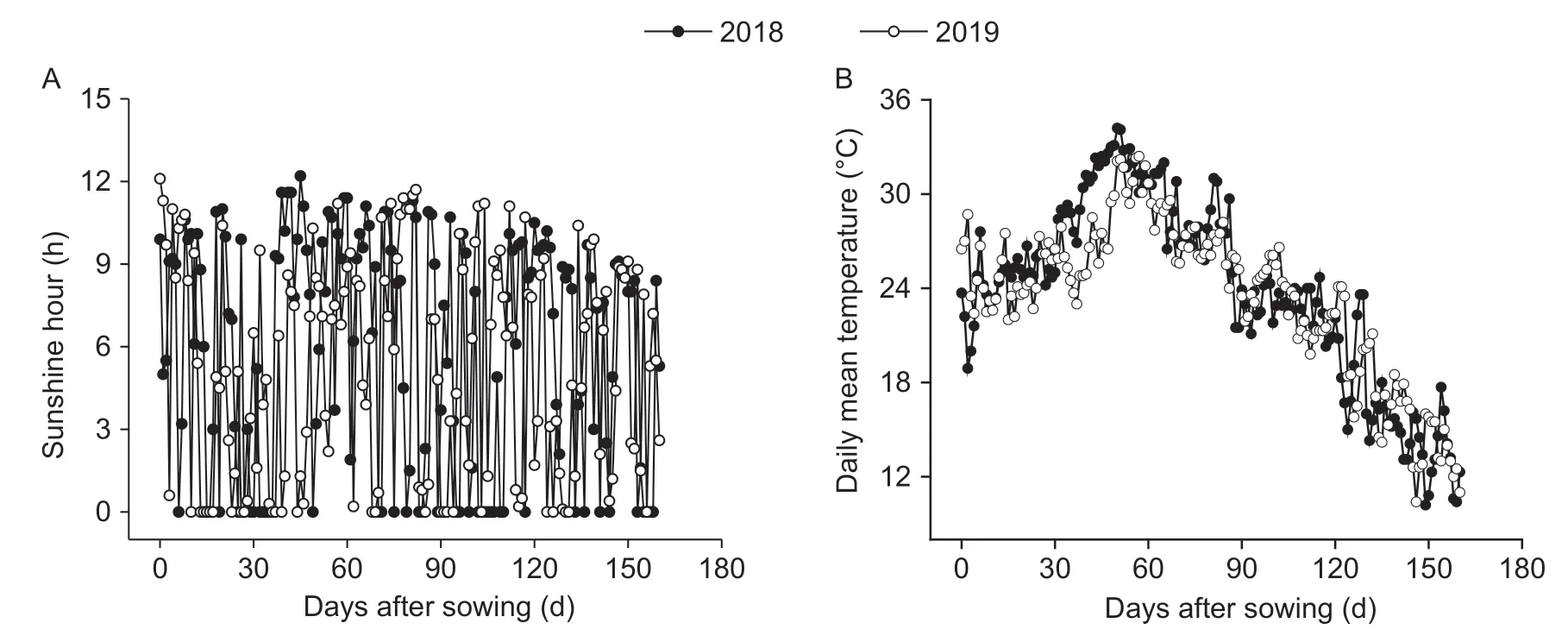
Fig.1 Sunshine hours (A) and daily mean temperatures (B) during the growing season of rice in 2018 and 2019.

Table 1 Details of the precise quantitative nitrogen application treatments
2.3.Sample and data collection
At maturity stage,rice yield was determined from all plants in a 6.0-m2area (except for border plants) in each plot and was calculated based on a standardized moisture content of 14%. The number of panicles m–2,number of spikelets per panicle,seed setting rate,and 1 000-grain weight,were determined from 50 plants (excluding border plants)sampled randomly from each plot. Harvest index was calculated by grain yield divided by total dry matter produced above ground. We assessed the SPAD values of leaves using a chlorophyll meter (SPAD-502,Soil-Plant Analysis Development Section,Minolta Camera Co.,Osaka,Japan)at jointing stage (JS),heading stage (HS) and maturity stage(MS). Ten leaves were randomly selected from each plot,and three points (top,middle and bottom) were measured on each leaf. Average values were calculated. Total aboveground biomass and leaf area index (LAI) were determined according to Huet al.(2016). To record the total aboveground biomass,the sampled plants were dried at 105°C for 30 min to stop biological activity,and then dried to constant weight at 80°C (DHG-9625A,Shanghai Yiheng Scientific Instruments Co.,Ltd.,Shanghai,China). A LI-3100C area meter (LI-COR,Inc.,USA) was used to measure the leaf area of each green leaf,then the leaf area per square meter was calculated as LAI. Six hills of plants were sampled from each plot according to average tiller numbers at jointing stage (JS),heading stage (HS) and maturity stage (MS).
Total N analysis was conducted on plant samples collected at PI,HT and MS. The plant samples (0.50 g)were digested for 2 h in H2SO4-H2O2solution at 420°C and analysed by the micro-Kjeldahl method (KjeltecTM8400,FOSS,Denmark). N uptake was calculated using the formula TDM×NC,where TDM represents the total dry matter of panicles,leaves and stems with leaf sheaths,and NC represents the N concentration in panicles,leaves and stems with leaf sheaths. The components of N use efficiency,such as N dry matter production efficiency(NDMPE),N grain production efficiency (NGPE),NRE,NAE,and N physiological efficiency (NPE) were calculated by the following formulas (Hanet al.2015):
NDMPE=TBup/TNup
NGPE=GY/Nup
NRE=(Nup-0Nup)/FN
NAE=(GY-GY0)/FN
NPE=(GY-GY0)/(Nup-0Nup)
whereTBupandTNup,the total above-ground biomass and total N uptake above-ground,respectively;GY andGY0,grain yields in N-fertilized plots and 0N plots,respectively;Nupand0Nup,total N uptake above-ground in N-fertilized plots and 0N plots,respectively;FN,the total N application rate in N-fertilized plots.
2.4.Data analysis
The statistical analyses consisted of analyses of variance(ANOVAs). Means were compared by the least significant difference (LSD) test at the 0.05 probability level. All statistical analyses were conducted using the SPSS software package (18.0;SPSS Inc.,Chicago,IL,USA),and graphs were generated using Origin 8.0 (OriginLab,Hampton,MA,USA).
3.Results
3.1.Grain yield and harvest index
Analysis of variance showed that the yield differences among years,varieties and treatments were all significant(P<0.05). The yield of reduced time of nitrogen application(RTN)3 was the highest both in 2018 and 2019 (Table 2).Under the same nitrogen rate,the average yield of RTN3 was 2.72–16.48% higher than that of other treatments across 2018–2019. Compared with FFP,the yield of RTN3 increased by 9.64 and 10.18% in NJ9108 and NJ5718,respectively. The panicle number m–2and spikelet number per panicle of RTN3 were on average 5.69–13.96%and 3.82–21.48% higher than those of other treatments,respectively. The panicle number m–2and spikelet number per panicle of RTN3 were on average 13.96 and 9.64%higher than those of FFP across 2018–2019,respectively.Among treatments with the same nitrogen application rate,FFP had the highest seed setting rate,which was 2.34–5.29% higher than other treatments (Table 2). Under the same nitrogen application rate,RTN2 had the highest harvest index,which was 4.08–6.25% higher than that of other treatments.
With the decrease of nitrogen application,the yield decreased gradually,which was mainly due to the decrease of panicle number m–2and spikelet number per panicle(Table 2). Compared with RTN3,the yields of reduced nitrogen rate (RNR) 1,RNR2 and RNR3 decreased by 8.31,13.78 and 27.51%,respectively. Compared with RTN3,the average panicle number m–2and spikelet number per panicle of the nitrogen-reducing treatments decreased by 7.04–34.36% and 1.28–13.33%,respectively. With the decrease of nitrogen application rate,seed setting rate and1 000-grain weight both increased,with those of nitrogenreducing treatments being 1.14–3.44% and 3.8–0.25%higher than those of RTN3,respectively. In contrast,the reduced nitrogen application rate led to decreases in the harvest index of nitrogen-reducing treatments by 6.12–18.37% compared with RTN3 (Table 2).
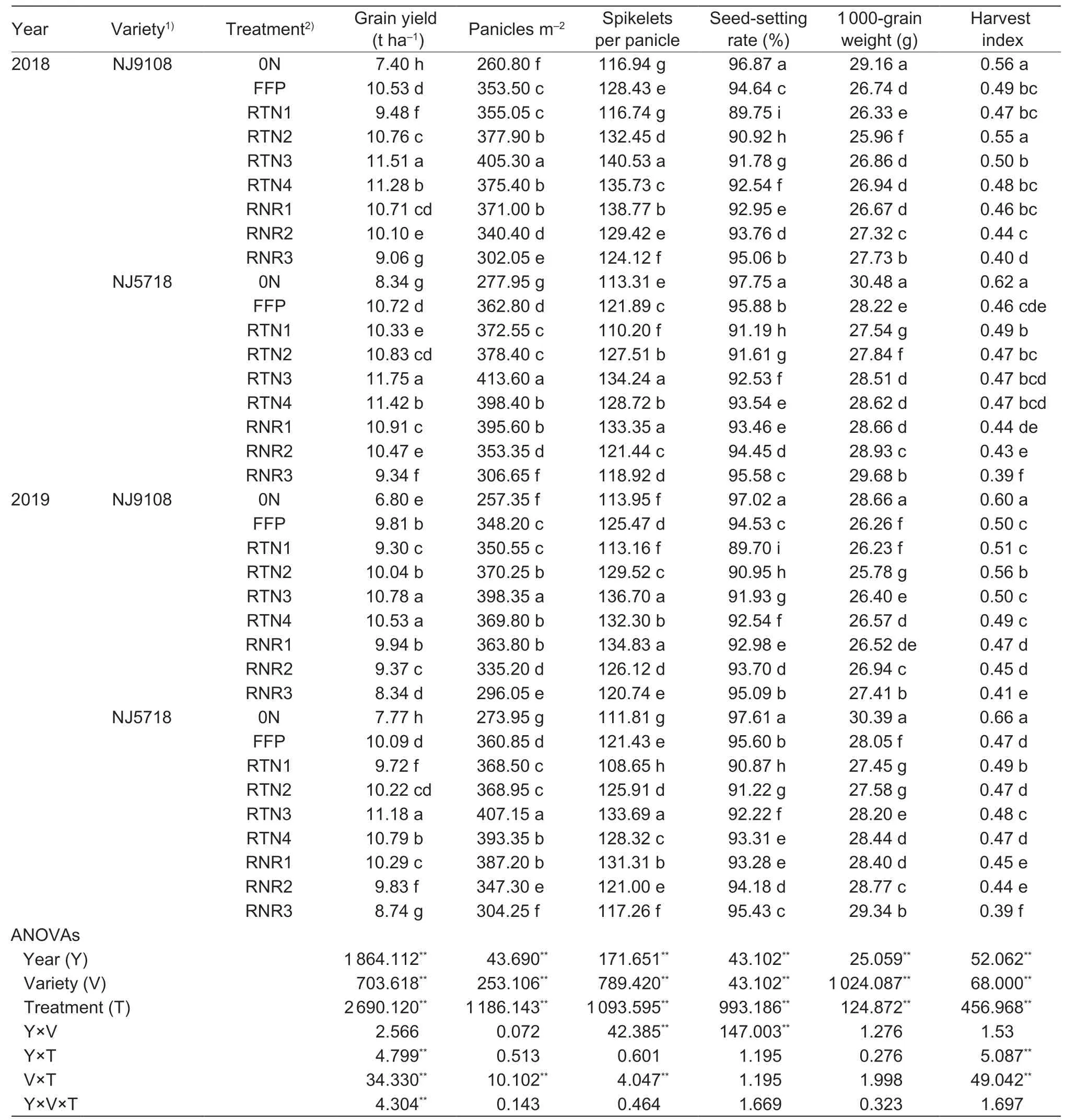
Table 2 Effects of different fertilization modes on the grain yield,yield components,and harvest index of rice in 2018 and 2019
3.2.SPAD values and LAI
The results of variance analysis showed significant differences in SPAD values and LAI between the two years and among the treatments (Tables 3 and 4). SPAD values and LAI at HS were higher than those at JS and MS. The SPAD value of RTN3 was significantly higher than that of other treatments at MS. The average LAI of RTN1 was 1.01–2.32 times that of other treatments under the same nitrogen application rate at jointing stage.The LAI of RTN2 was on average 1.0–1.78 times that of other treatments under the same nitrogen application rate at HS. The LAI of RTN3 was on average 1.0–2.22 times that of other treatments under the same nitrogen application rate at MS. Compared with RTN3,the SPAD values of RNR1,RNR2 and RNR3 decreased by 0.4,2.72 and 7.09%,respectively (Table 3). With the decrease of nitrogen application,the LAI of RNR1,RNR2 and RNR3 decreased gradually compared with RTN3 across 2018–2019 (Table 4).

Table 3 Effects of different fertilization modes on the SPAD value of rice in 2018 and 2019
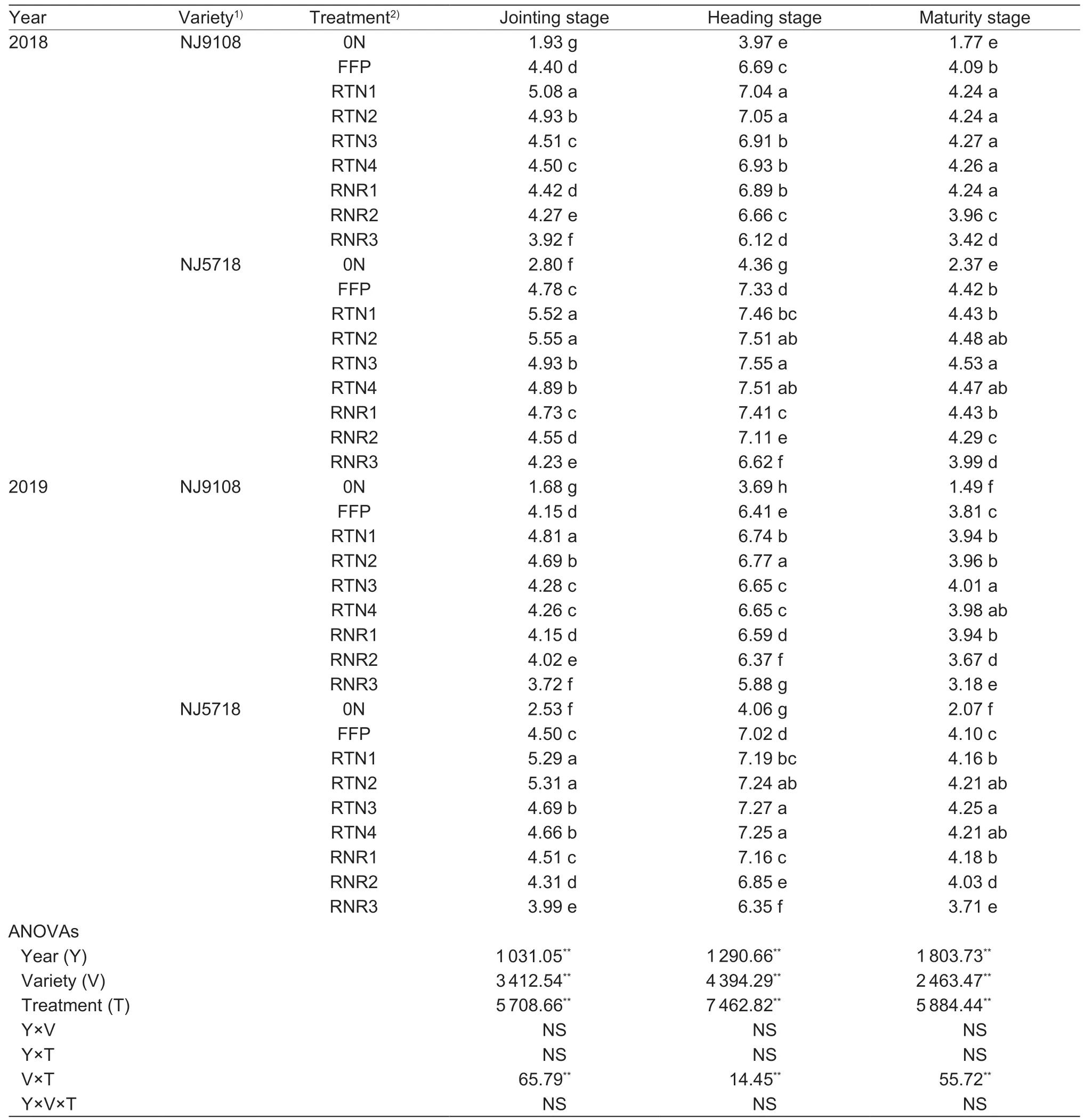
Table 4 Effects of different fertilization modes on the leaf area index (LAI) values of rice in 2018 and 2019
3.3.Dry matter accumulation
The analysis of variance among years,varieties and treatments showed that the differences of dry matter accumulation from sowing to JS,from JS to HS,from HS to MS and across the whole growth period were all very significant (Table 5). At jointing stage,the dry matter accumulation of RTN1 was 0.04–2.79 t ha–1higher than that of other treatments. The dry matter accumulation of RTN3 was 0.06–4.24,0.05–5.07 and 0.14–10.76 t ha–1higher than that of other treatments at heading,maturity and other growth stages,respectively. With the decrease of nitrogen application,compared with RTN3,the dry matter accumulation of nitrogen-reducing treatments at jointing,maturity and other growth stages decreased by 0.05–0.85,0.02–0.08 and 0.03–0.95 t ha–1,respectively (Table 5).
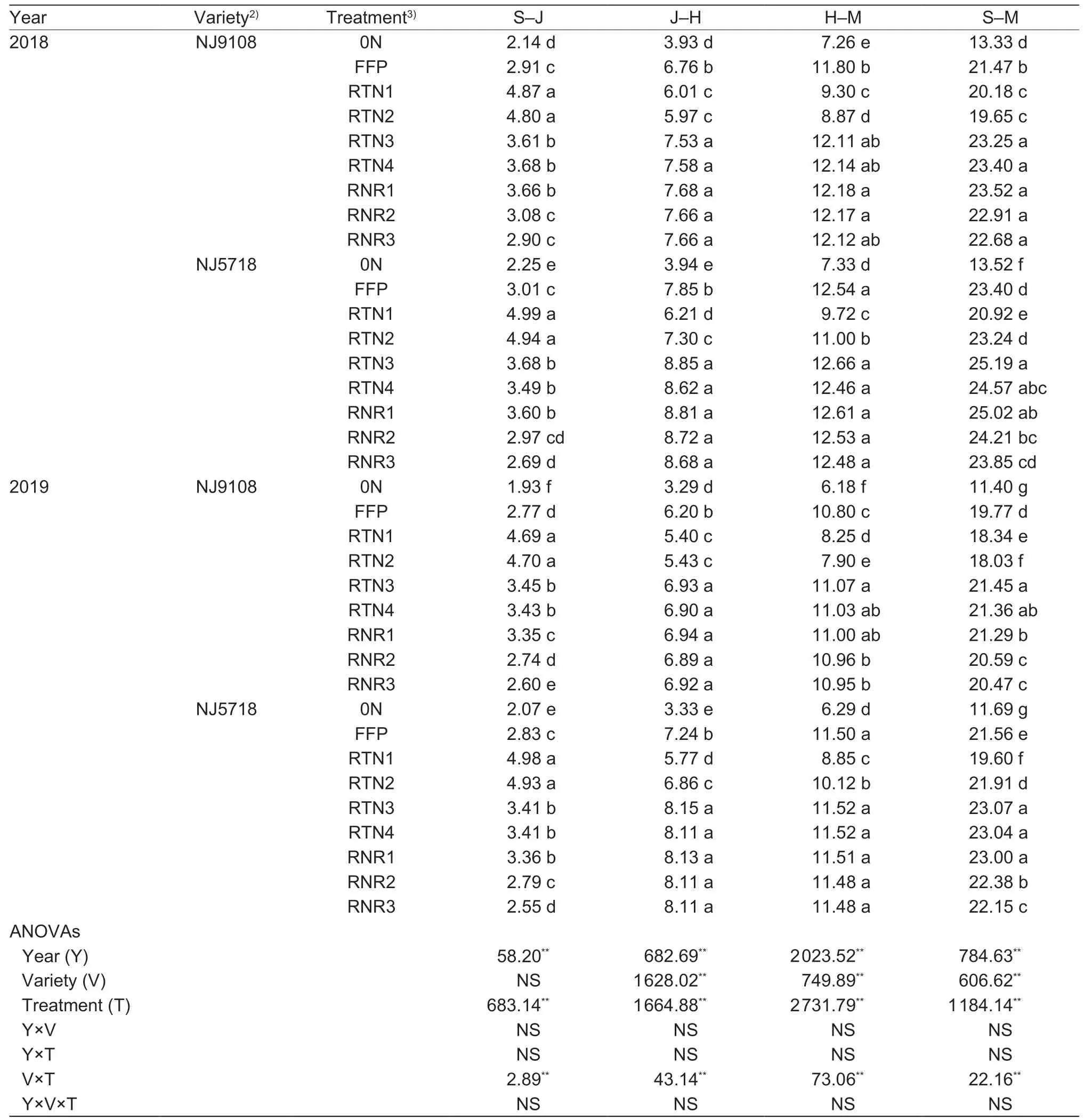
Table 5 Effects of different fertilization modes on the dry matter accumulation of rice in 2018 and 20191)
3.4.Nitrogen accumulation
The analysis of variance showed significant differences in nitrogen accumulation between years,treatments and varieties,from sowing to JS,from JS to HS,from HS to MS,and across the whole growth period. In terms of interaction effects,there were significant differences between years and treatments,years and varieties,and varieties and treatments (Table 6). The nitrogen accumulation of RTN2 was on average 0.14–6.76×10–2t ha–1higher than that of other treatments from sowing to JS. RTN3 had the highest nitrogen accumulation from JS to HS,and its average nitrogen accumulation was 11.3×10–2t ha–1across 2018 and 2019 (Table 6). Compared with RTN3,with the decrease of nitrogen application,the nitrogen accumulation of nitrogenreducing treatments decreased by 3.34–25.33% from sowing to JS. With the decrease of nitrogen application,nitrogen accumulation during the whole growth period decreased 5.35–24.55 kg ha–1compared with RTN3 (Table 6).
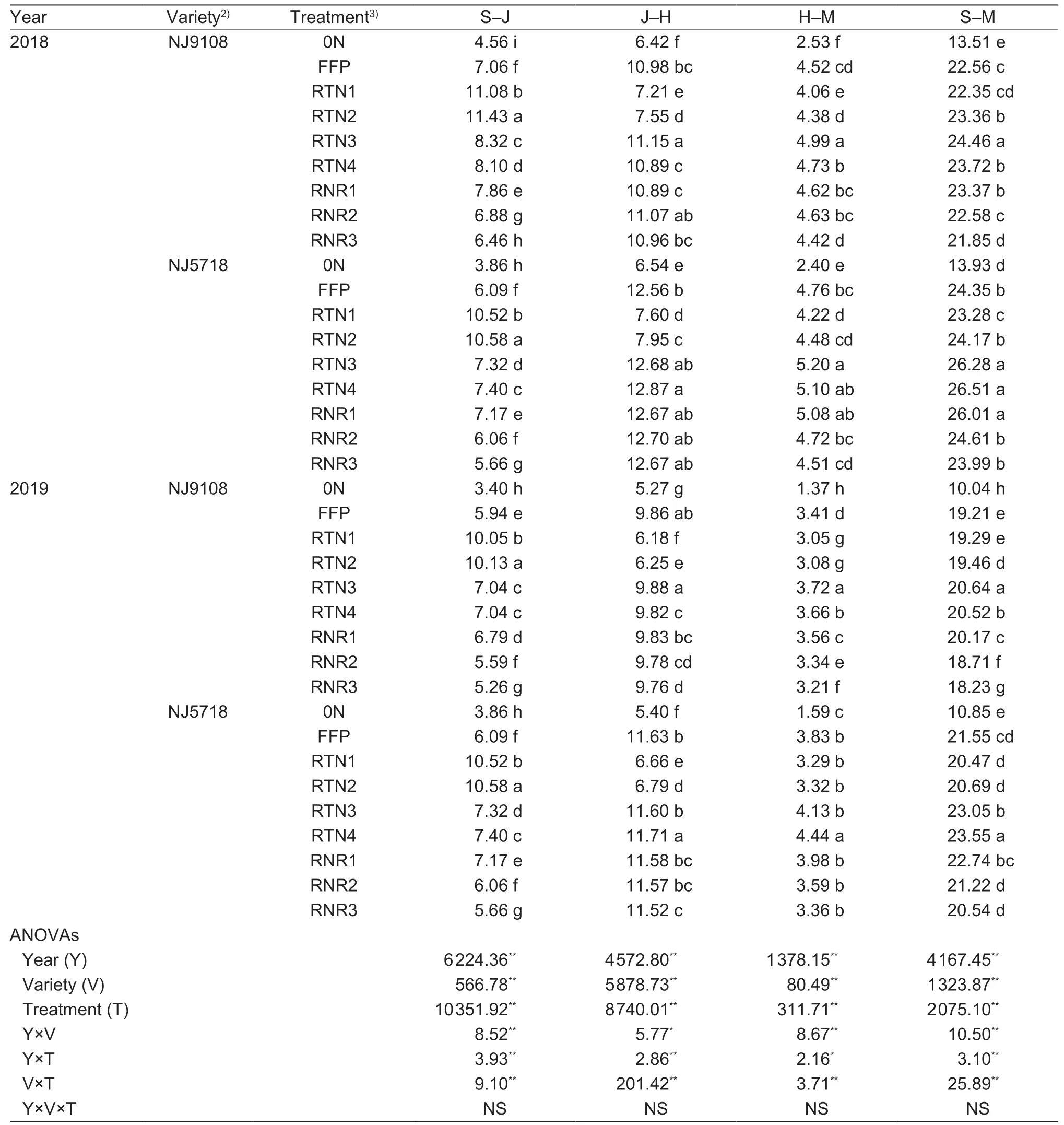
Table 6 Effects of different fertilization modes on the nitrogen accumulation of rice in 2018 and 20191)
3.5.Nitrogen use efficiency
Under the same nitrogen application rate,NJ9108 and NJ5718 had the highest NAE in RTN3,with averages of 13.48 and 11.37 t t–1,respectively,which were 8.1–21.28%higher than those of other treatments (Fig.2-A and B). The N physiological efficiency (NPE) of RTN3 was the highest,which was on average 8.51–41.76% higher than that of other treatments across 2018 and 2019 (Fig.2-C and D). 0N had the highest N dry matter production efficiency (NDMPE) at 104.58 t t–1,followed by RTN3 at 98.87 t t–1(Fig.3-A and B).0N had the highest N grain production efficiency (NGPE),which was 63.68 t t–1. Among the treatments with 300 kg N ha–1,the NGPE of RTN3 was the highest at 48.18 t t–1(Fig.3-C and D). The NRE of RTN3 was the highest at 38.77%,which was on average 0.28–14.52% higher than that of other treatments (Fig.4).
NAE decreased with the reduction of nitrogen application rate,which was on average 16.71–56.12% lower than that in RTN3 across 2018 and 2019 (Fig.2-A and B). NDMPE increased with the decreasing nitrogen application rate,and the nitrogen-reducing treatments increased by 2.16–7.22%compared to RTN3 (Fig.3-A and B). Compared with RTN3,NGPE and NPE of the nitrogen-reducing treatments on average decreased by 4.55–12.31% and 18.03–55.07%,respectively (Figs.2-C and D,3-C and D). With the reduction of nitrogen application rate,NRE showed no significant differences among treatments in either 2018 or 2019,and the NRE of RNR1 was the highest (Fig.4).
4.Discussion
4.1.Effects of different fertilization modes on rice yield
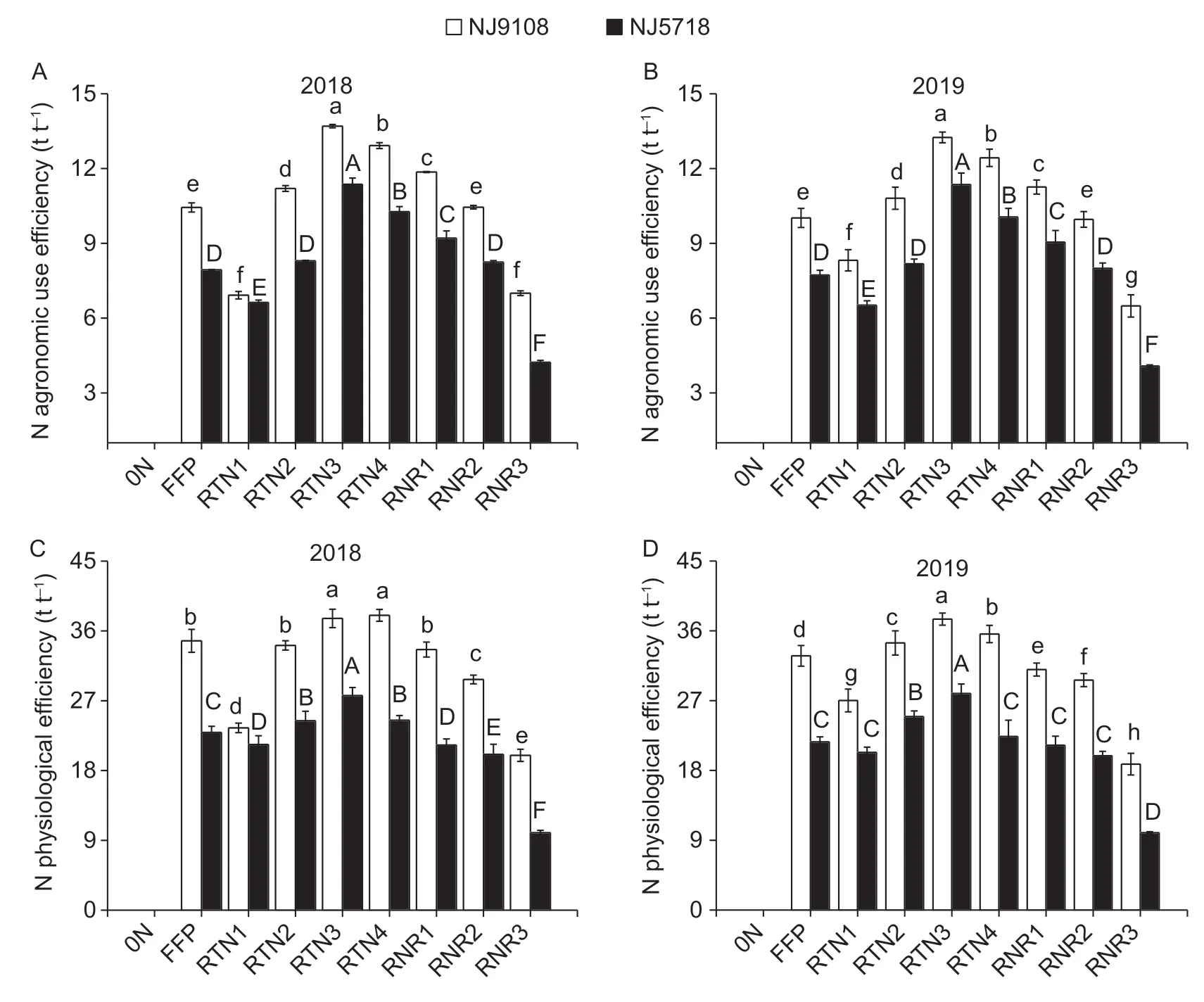
Fig.2 Effects of different fertilization modes on the nitrogen (N) agronomic use efficiency (NAE) (A and B) and N physiological efficiency (NPE) (C and D) of rice in 2018 and 2019. 0N,FFP,RTN,and RNR represent no nitrogen application,farmers’ fertilizer practice,reduced time of nitrogen application,and reduced nitrogen rate. Bars mean SE (n=3). Different lowercase letters indicate statistical significance at P=0.05 of Nanjing 9108 (NJ9108);different capital letters indicate statistical significance at P=0.05 of Nanjing 5718 (NJ5718).

Fig.3 Effects of different fertilization modes on the nitrogen (N) dry matter production efficiency (NDMPE) (A and B) and N grain production efficiency (NGPE) (C and D) of rice in 2018 and 2019. 0N,FFP,RTN,and RNR represent no nitrogen application,farmers’ fertilizer practice,reduced time of nitrogen application,and reduced nitrogen rate. Bars mean SE (n=3). Different lowercase letters indicate statistical significance at P=0.05 of Nanjing 9108 (NJ9108);different capital letters indicate statistical significance at P=0.05 of Nanjing 5718 (NJ5718).
It is well-known that panicles m–2,spikelets per panicle,seed setting rate,and 1 000-grain weight are the key components of rice yield (Xieet al.2019). In the present study,we found that under side deep fertilization,the yield was the highest in RTN3 at the nitrogen application rate of 0.3 t ha–1both in 2018 and 2019 (Table 2). This high yield is mainly due to large panicles m–2and spikelets per panicle that lead to the formation of large panicles with a large sink size. Our results are consistent with Zhanget al.(2019b) who found that integrative crop management could improve rice yield,which was mainly attributed to high panicles m–2and spikelets per panicle. Generally speaking,high grain yield usually needs high N input (Yinet al.2009;Zhanget al.2018).We also found that compared with FFP,RTN3 reduced fertilization frequency twice while increased yield by 9.91%(Table 2). Scientifically determined amounts of nitrogen fertilizer application and operation methods can promote the formation of effective tillers,which increases number of panicles m–2and forms a more substantial population (Linget al.1993;Eagleet al.2000;Huet al.2016).
Baiet al.(2014) showed that side deep fertilization could promote the rice growth process,and yield was increased by increasing spikelets m–2. Deep fertilization could deliver nutrients precisely to the root zone and reduce ammonia volatilization and surface runoff,which increased grain yield(Rahman and Barmon 2015;Mazidet al.2016;Zhanget al.2017). Deep placement of nitrogen significantly decreased cumulative NH3volatilization by 15–45%,and increased grain yield by 5–11% (Liuet al.2015). We found that with the nitrogen application at panicle differentiation stage,the 14th leaf order stage,the yield was 8.13% higher than that with the application at mid-tillering stage. At the 14th leaf order stage,increasing nitrogen application rate could promote normal physiological metabolism during the grain-filling stage of leaves,preventing early senescence of leaves,and maintaining a high level of source-sink activity of rice (Zhonget al.2007;Li Bet al.2018). Nitrogen fertilizer application at panicle differentiation stage could increase number of panicles m–2,spikelets per panicle,seed setting rate,and 1 000-grain weight,and ultimately increase yield (Dinget al.2003;Wanet al.2007). Under appropriate amount of fertilizer,the higher the basal tiller fertilizer is,the higher the number of panicles m–2will be. However,excessive basal and tiller fertilizer can inhibit tillering,which leads to the decrease of panicle number.
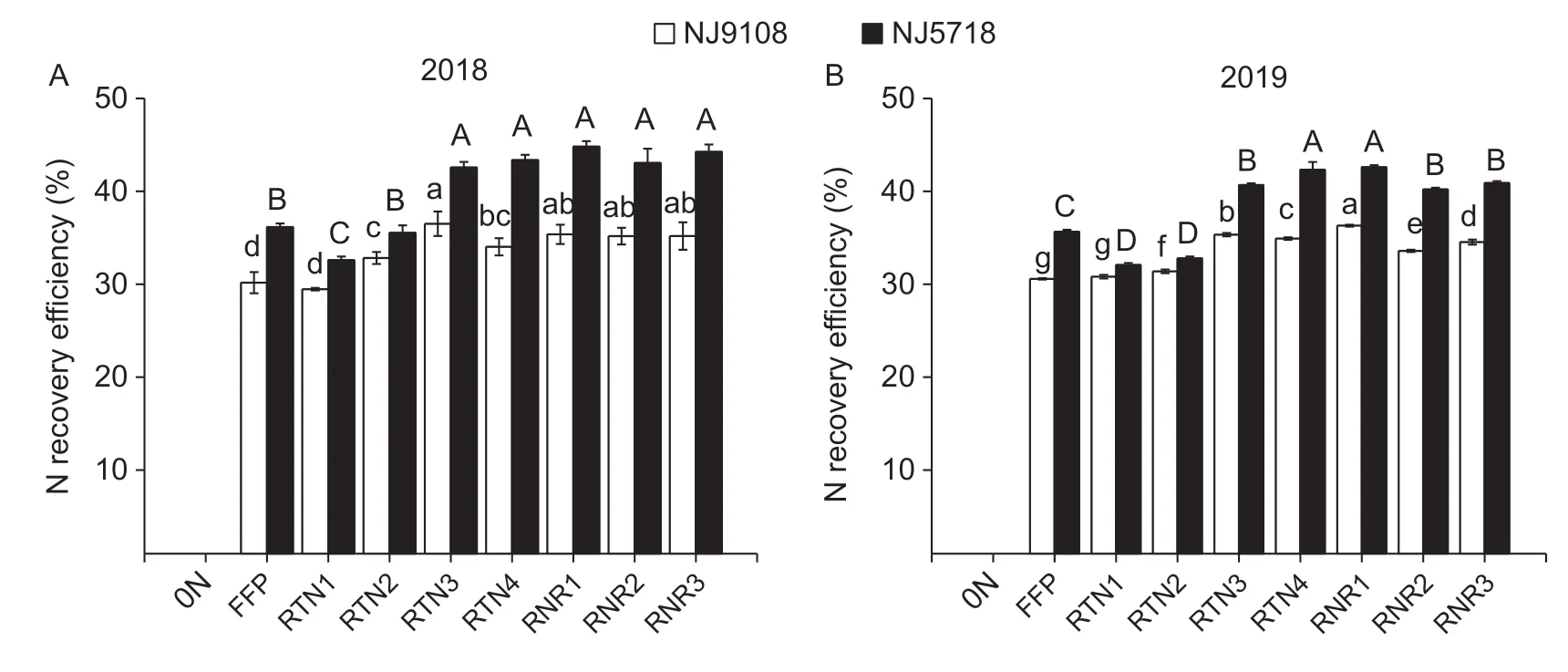
Fig.4 Effects of different fertilization modes on nitrogen (N) recovery efficiency (NRE) of rice in 2018 (A) and 2019 (B). 0N,FFP,RTN,and RNR represent no nitrogen application,farmers’ fertilizer practice,reduced time of nitrogen application,and reduced nitrogen rate. Bars mean SE (n=3). Different lowercase letters indicate statistical significance at P=0.05 of Nanjing 9108 (NJ9108);different capital letters indicate statistical significance at P=0.05 of Nanjing 5718 (NJ5718).
Photosynthesis is very important for achieving a high or super-high yield of rice at heading stage. About 90% of rice yield comes from photosynthesis,and about 60–80%of the yield comes from the products of photosynthesis after heading (Guet al.2012;Zhanget al.2018). LAI is helpful for measuring the canopy light interception,photosynthetic capacity and biomass of crops (Vaesenet al.2001). At higher LAI values,greater amounts of dry matter would be compounded and transported to reproductive parts,generating a higher grain yield (Zenget al.2012). In our study,SPAD value,LAI and dry matter accumulation all increased from tillering,and peaked at heading stage before decline (Tables 3,4 and 5). Compared with PPF,side deep placement of nitrogen improved the SPAD value,LAI and dry matter accumulation of rice (Tables 3,4 and 5). Side deep fertilization could promote an early green up and tillering,and significantly increase the dry matter accumulation of rice(Yang and Wang 2018;Zhuet al.2019a). It is worth noting that under side deep placement of nitrogen,we found that the SPAD value and LAI of RTN3 were not the highest at heading stage among all fertilization modes,while RTN3 had the highest SPAD value,LAI and dry matter accumulation at maturity stage (Tables 3,4 and 5). Properly increasing leaf area was found conducive to improving photosynthetic productivity and promoting grain filling after heading stage(Zhanget al.2010). At maturity stage,RTN3 can maintain a certain leaf area for photosynthesis,which is one of the reasons for high yield. A reasonable canopy structure was found conducive to the construction of high-yielding populations,and improving the photosynthetic capacity of rice at grain-filling stage would be an important way to obtain high-yielding rice (Martinet al.2009). With the decrease of nitrogen application rate,the yield,dry matter accumulation,SPAD value,and LAI all decreased gradually. The decrease of yield was mainly due to the decreases of panicles m–2and spikelets per panicle (Tables 3,4 and 5). Our results are consistent with Xuet al.(2015) who found that decreasing nitrogen led to a reduction of the total number of spikelets,but improved grain weight (26.7–31.5 mg) and grain filling(88.4–92.1%). However,under side deep placement of nitrogen,the yield of RNR1 was higher than that of RNR2 and RNR3. The average yields of NJ9108 and NJ5718 of RNR1 were 10.33 and 10.60 t ha–1,respectively (Table 2).RNR1 is worthy of further application in China,in order to decrease nitrogen use and reduce environmental pressure.Moreover,furture research needs to investigate under the condition of side deep fertilization,how to achieve high yield through reducing nitrogen use and increasing planting density.
4.2.Effects of different fertilization modes on nitrogen accumulation and nitrogen use efficiency
Under the same nitrogen application rate,RTN3 had greater nitrogen accumulation during sowing to jointing stage (JS),JS to HS,HS to MS and the full growth period (Table 6).Nitrogen broadcasting is a kind of imprecise fertilization method resulting in high loss of nitrogen in paddy fields.On the contrary,side deep placement of nitrogen is more conducive to nitrogen accumulation (Khalilet al.2009;Liuet al.2015). We found that under the same nitrogen application,the NAE,NRE and NPE of RTN3 were higher than those of other treatments (Figs.2 and 4). The high nitrogen use efficiency obtained by side deep placement of nitrogen agrees with the findings from other studies(Jaiswal and Singh 2001;Chenet al.2008;Zhuet al.2019b).Nitrogen deep placement increased NAE by 30–54% in paddy fields compared with nitrogen broadcasting (Kapooret al.2018). Compared with FFP,side deep placement of nitrogen improved NDMPE and NGPE (Fig.3),which is in line with the finding by Xuet al.(2012) that side deep placement of nitrogen could accurately deliver nitrogen to the root zone and promote nitrogen absorption. The main inorganic nitrogen elements absorbed by plants are NO3-and NH4+,among which NO3-is mainly absorbed and utilized in aerobic soil,while NH4+is absorbed and utilized in paddy field or acidic soil (Fenget al.2011).Nitrogen deep placement reduced NH4+-N concentration and NH3volatilization,allowing more NH4+to exist in soil,and increasing the nitrogen absorption and utilization of rice (Mohantyet al.1999;Liuet al.2015). Compared with nitrogen broadcasting,side deep placement of nitrogen increased the storage time of nutrients in the soil,reduced the release of N2O and NO in paddy fields,and increased nitrogen use efficiency (Yaoet al.2017). Nitrogen accumulation,NAE,NDMPE,NGPE,and NPE all decreased with the reduction of nitrogen application rate (Figs.2 and 3);however,NRE had no significant difference among the treatments in 2018 and 2019,while NRE tended to increase within a certain range with the decrease of nitrogen application rate (Fig.4). Houet al.(2019) found that with the increase of nitrogen application rate,NRE decreased. Liet al.(2012) observed that an insufficient CO2supply under high N application led to a decrease in Rubisco activity,resulting in a disproportionate increase in photosynthetic rate and hence decreasing NRE. Penget al.(1996) also suggested that unproductive tillers before jointing stage were generally considered to be an important trait that might be responsible for low NRE. It is worth mentioning that the nitrogen in soil is absorbed and transported by rice roots,and then amino acids are synthesized through the GS/GOGAT cycle. Among the key enzymes,glutamine synthase (GS),glutamate synthase (GOGAT) and glutamate dehydrogenase (GDH) are the main ones involved in rice ammonia assimilation. Our experienment did not measure the changes in NH4+-N and NO3--N concentrations or the GS,GOGAT and GDH enzyme activities in soil under side deep placement of nitrogen. So clearly further research is needed.
5.Conclusion
The present study revealed that compared with FFP,reducing fertilizer application frequency can improve rice yield and nitrogen use efficiency under side deep placement of nitrogen. Under the same nitrogen rate (0.3 t N ha–1),the average yield,SPAD value,LAI,dry matter accumulation,nitrogen accumulation,and nitrogen use efficiency of RTN3 were higher than those of other treaments,achieving the dual production goal of high yield and high efficiency of rice.Compared with RTN3,RNR1 could be used as a cost-saving and efficiency-increasing fertilization mode. In conclusion,we have established a mode of precise quantitative fertilization. Under side deep fertilization,reducing nitrogen application frequency and application volume each time can provide high rice yield and high nitrogen use efficiency.
Acknowledgements
We are grateful for grants from the National Key Research and Development Program of China (2018YFD0300802 and 2016YFD0200805) and the Key Research Program of Jiangsu Province,China (BE2017343 and BE2018362).
Declaration of competing interest
The authors declare that they have no conflict of interest.
杂志排行
Journal of Integrative Agriculture的其它文章
- Low glycemic index:The next target for rice production in China?
- Effects of different types of slow-and controlled-release fertilizers on rice yield
- Advancements in plant regeneration and genetic transformation of grapevine (Vitis spp.)
- Indica rice restorer lines with large sink potential exhibit improved nutrient transportation to the panicle,which enhances both yield and nitrogen-use efficiency
- Effects of nitrogen management on the ratoon crop yield and head rice yield in South USA
- Response of grain-filling rate and grain quality of mid-season indica rice to nitrogen application
